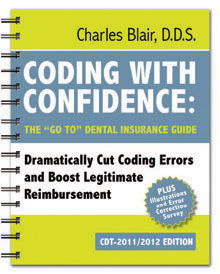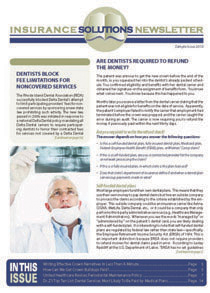By Dr. Charles Blair & Mr. David Jones
On a compounded basis, forgone revenues can reach millions of dollars over a 35- year career. Fee increases go directly to the bottom line. However, a broken appointment deprives the practice of the appointment’s cash flow. For example, all supplies and lab expenses average 14% –18% of revenues. Therefore, a broken $100 visit deprives the practice of $82 to $86 net cash flow or higher if a lab fee is not applicable.
Have you ever calculated the dollars it costs for broken appointments in only one year? The figure could be up to 25% of your take-home every year! Hygiene is generally the greatest economic killer.
The good news is that patients can learn to respond to their dental office in a different manner for the changing times and modern approach to optimal oral health. The changes have to begin with the doctor, staff, and the “corporate attitude.” Most patients will accept change if we exhibit the correct attitude and a positive professional image. Dental teams can convince that it is in the patient’s best interest to be on time and never break an appointment.
To be proactive and effective, it is necessary to understand why patients break appointments. The first reason is we have taught them that it is “OK” to casually miss an appointment. We must demonstrate how it is in their best interest to always keep appointments. Most people aren’t concerned that it costs the doctor money for the missed appointment. We must show the patients the consequences of broken appointments as it affects their well-being and not ours.
The second reason patients break appointments is that on the day of “case acceptance” they thought they could pay, but by the time of their treatment appointment, they do not have the funds. Many times, patients are embarrassed to call and simply do not show. The best remedy for this is preventative medicine.
Tell the patient, “John, this treatment really is in your best interest. I’m saving time just for you, so be sure and be on time every time as we progress through this together!” You must build importance and value with the patient. The practice should also offer easy payment plans through third-party financing companies. This will prevent “no shows” on the day of the appointment.
The third reason for broken appointments is a lack of value in the patient’s mind. Never believe that because a patient nods the head in approval there is a commitment. For real commitment to be in place, the dental team must do several things:
Have you ever calculated the dollars it cost for broken appointments in only one year? The figure could be up to 25% of your take-home every year! Hygiene is generally the greatest economic killer.
- There must be a “buy in” as to the dental problem. The best tools available for this are the intraoral and digital camera and digital X-ray.
- The patient must “understand” the solution to their problem. A picture is worth a thousand words, and patient education software such as Guru is extremely valuable.
Additionally, the team can use study models and various pictures from periodicals to demonstrate dental solutions. People are not committed to what they don’t understand. - The third way to secure commitment is to rehearse verbal skills in case presentation and value building. There are numerous resources for this process.
- Avoid thinking that your patients trust you so much, that it is not necessary to build value with these tools. To assume that patients will reach for their wallet at your command is a sure path to poverty.
One huge priority for all dental teams in building value for appointments is centered on studies revealing the correlation of periodontal disease and heart disease. An article by the late periodontist John W. Peden states: “Studies involving almost 50,000 people in four different countries continue to verify the association between periodontal disease and heart disease, including death from heart disease. People with periodontal disease have 1.7 times the risk of heart disease and 2.2 times the risk of death. The culprit appears to be porphyromonas gingivalis, the most common strain of bacteria found in periodontal disease, which causes blood clots that induce heart attacks when they escape into the bloodstream.”
Chronic inflammation of the gums due to p. gingivalis also could be involved in arteriosclerosis, the inflammation of the blood vessel lining leading to the buildup of plaque in the arteries and the underlying cause of most heart disease. These same bacteria are also linked to infective endocarditis, an infection of the heart valves.
It is imperative that we use all means possible to convey the above information to patients in understandable form. The proper presentation of this material emphasizes the importance of dental visits. Most dentists need a paradigm shift in their own thinking. Once dentists and staff believe dental office visits are not optional, they can convey this to their patients.
The fourth reason patients break appointments is the mistaken perception that the practice is so busy it won’t make any difference if they come or not. Not running on time perpetuates this perception. The unbooked operatory enhances on-time performance and same-day dentistry production. The team must find creative ways to demonstrate that despite busyness, every person is important to the doctor and all must work together for total health.
It’s equally important to discern the four categories of patient visits in order to prevent broken appointments. Each category requires a unique strategy.
First is the emergency visit. Usually this appointment is scheduled the same day the patient calls. It’s a good idea to develop criteria for what constitutes an emergency. A telephone script reflecting the doctor’s policy is helpful. Don’t be afraid to let the emergency patient know that “working them in” is a challenge and they are fortunate to be seen so quickly. Provide appropriate treatment that allows the doctor and staff to stay on schedule for regular patients. Always emphasize that this is “exclusive time for you.” For emergency visits the next day, call the patient 24 hours in advance. Prompt your message by noting, “The doctor is saving this special time for you because of your emergency. It is imperative that you be on time. I’m sure the doctor can help you.”
Remember that all forms of communication can be a training session for patients. Be sure they understand that dental visits are not optional. Good total health begins at the mouth (for practice and for patients).
The second category of patient visits is the “New Patient.” To decrease broken appointments, be sure to see the patient within three to six working days. “The quicker the better” is the watch phrase here, as the new patient has no relationship with the dentist and could easily break the appointment. Remember that when they called for their new visit, they had money and commitment, but elapsed time can deplete both.
Develop a telephone script for booking the new patient. For the price of a few minutes a day, any doctor can work miracles in broken-appointment prevention. The doctor should call the new patient 48 hours in advance with this or a similar message: “Mrs. Jones, this is Dr. Smith. I noticed you are on my schedule at 2:00 p.m. Thursday. I look forward to meeting you the day after tomorrow.” Now the patient knows the doctor is aware of the visit and will have to suffer embarrassment if they do not show. The call takes less than a minute during the clinical day.
The third category is the “Treatment” visit. Confirm the appointment 48 hours in advance; if the patient should postpone their visit, you need time to fill their slot. Avoid language such as: “I’m calling to confirm your appointment.” This creates negative thoughts for the patient such as: “This is my last opportunity to back out and I better take it.” Rather use words like: “Mr. Jones, we’re calling to see if you have any questions regarding your dental visit on Thursday at 2:00 p.m.” Or “Mr. Jones, we’re looking forward to seeing you Thursday at 2:00 p.m.”
The fourth category and most often broken visit is the “re-care visit.” Each hygiene visit is an opportunity to train patients on the importance of regular care and unbroken appointments. Never say, “just a cleaning.” Always give the patient additional reasons to return other than a cleaning. Prevention of periodontal problems, oral cancer exams, bad breath prevention, etc. is all good reasons for the patient to be faithful in their appointment commitments. Reinforce at every visit a “reason” to return and that appointments are reserved exclusively for the patient. Automated patient contact software such as Demandforce will increase efficiency, decrease broken appointments, and re-activate patients while the patient survey feature enhances Google search ranking.

Coding with Confidence:The “Go-To” Dental Insurance Guide (CDT-2011/2012 Edition) Henry Schein, Inc. Item Code (367-7233)
Remember that all forms of communication can be a training session for patients. Be sure they understand that dental visits are not optional. Good total health begins at the mouth (for practice and for patients).
Dr. Charles Blair is author of Coding With Confidence: The “Go To” Dental Insurance Guide (available through Henry Schein order # 367-7233). He is also publisher of Insurance Solutions Newsletter (available through Henry Schein order #367-7329 for a one year subscription and order #367-7330 for a two year subscription). He can be reached at info@drcharlesblair.com.
David Jones is CEO of David Jones Consultants. He has 24 years experience helping dentists achieve profitability. He can be reached at David6705@sbcglobal.net. or 559-999-7609.
This is a unique reference guidebook that goes beyond the typical “list and describe” coding handbook. This book was developed using information compiled from thousands of interviews with doctors and staff just like you, and uses PREDICTIVE ERROR CORRECTION™ technology to help predict common mistakes before you make them!

Insurance Solutions Newsletter Henry Schein, Inc. Item Code: 1-year subscription (367-7329) and 2-year subscription (367-7330). Place your order with Henry Schein Dental at 1-800-372-4346 or visit us on the Web at henryscheindental.com
This manual provides expert assistance to practice staff finding it difficult to keep up with the frequent changes, revisions, and deletions in the CDT codes, mandated every other year. It utilizes reader-friendly graphics, like the Coding Correction, Warning, and Watch icons, illustrations, flowcharts, etc. to ensure you know what to look out for with hundreds and hundreds of different CDT codes.
Description of Newsletter: Insurance Solutions Newsletter enjoys a national reputation as dentistry's leading resource for accurate dental coding and insurance information. Each bi-monthly issue contains sixteen pages of the most detailed and current step-by-step guidance in the industry. When addressing controversial coding and insurance issues, our researchers seek advisory opinions from the American Dental Association, the American Academy of Periodontology, the American Association of Endodontists, the American Association of Oral and Maxillofacial Surgeons, insurance directors, and claims examiners to provide you with the information you need to bill claims accurately–the first time.
